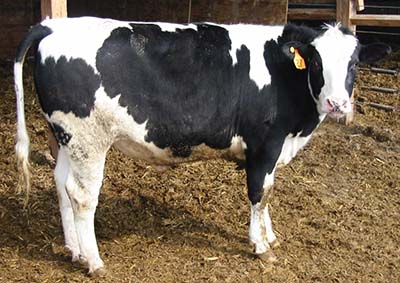New publication shares survey data from beef x dairy raisers and feedlot operators
6/11/24

AMES, Iowa – Although dairy animals have traditionally made up about 20% of the beef supply, packer decisions in 2017 to stop purchasing fed dairy steers have led those producers to make different choices in their genetics and breeding decisions. Early semen selection approaches provided black-hided cattle but with conformation more closely matching straight-bred dairy cattle.
With little direct connection between feedlots and dairy farms, it's difficult to obtain data from the common link: beef on dairy (BXD) calf raisers and ranches, and producers finishing BXD calves. An Iowa Beef Center-led study focused on this link with surveys of both groups in or near Iowa.
The spring 2023 survey had two objectives: learn about management practices employed by dairy producers and calf ranches that raise BXD crossbred calves, and learn about challenges related to finishing BXD calves from commercial feedlot operators.
"Because calf health is a big concern, we asked producers how their calves were sourced, and about colostrum intake and quality," said Iowa State University extension beef specialist Denise Schwab. "We also asked about pre-weaning and post-weaning death loss, and starter feed diets."
Respondents identified a number of overall concerns, including mycoplasma, scours, and low resale value, and yet increased income to the dairy was the most cited reason for raising BXD calves. They also said more research is needed in several areas, including reducing liver abscesses, sire genetics and selection, and improving carcass cutout.
Feeders who finish BXD calves were asked to describe their feeding experience compared to their respective beef or dairy cattle experience. They also provided the timing and cause of morbidity and mortality. The major cause of death for straight-bred beef and straight-bred dairy was respiratory/pneumonia/Bovine Respiratory Disease, while 73% of BXD feeders reported similar cause of death.
The survey also asked about implant strategies for BXD cattle, where cattle are marketed, incidence and discount for liver abscesses, and quality grade and yield grade of marketed cattle.
Survey results show improvement and progress in changing the type and quality of the BXD crossbred animal, while recognizing more is needed. More communication among and between segments of the production chain will be key to success. More research is needed to select the ideal beef bulls based on growth, performance, and carcass merit without compromising calving ease.
The study was made possible with funding from the Iowa Beef Industry Council and the Iowa Beef Checkoff.
A new five-page publication details this study, results, and findings. A Survey of Iowa Beef X Dairy Calf Raisers and Feedlot Operators to Further Describe Challenges Related to Finishing BXD Crossbreds, IBC148 is available as a free download from the ISU Extension store.
-30-
The Iowa Beef Center at Iowa State University was established in 1996 with the goal of supporting the growth and vitality of the state’s beef cattle industry. It comprises faculty and staff from Iowa State University Extension and Outreach, College of Agriculture and Life Sciences and College of Veterinary Medicine, and works to develop and deliver the latest research-based information regarding the beef cattle industry. For more information about IBC, visit www.iowabeefcenter.org.
Contact:
Denise Schwab, ISU Extension and Outreach beef specialist, 319-721-9624, dschwab@iastate.edu
